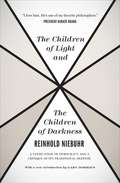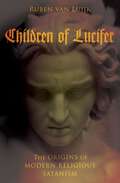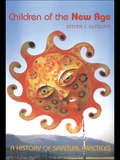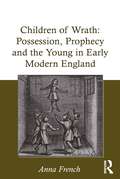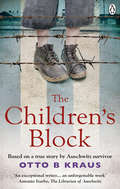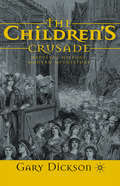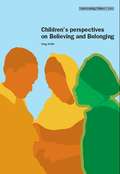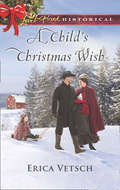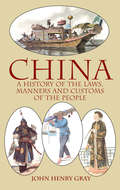- Table View
- List View
The Children of Light and the Children of Darkness: A Vindication of Democracy and a Critique of Its Traditional Defense
by Reinhold NiebuhrThe Children of Light and the Children of Darkness, first published in 1944, is considered one of the most profound and relevant works by the influential theologian Reinhold Niebuhr, and certainly the fullest statement of his political philosophy. Written and first read during the prolonged, tragic world war between totalitarian and democratic forces, Niebuhr’s book took up the timely question of how democracy as a political system could best be defended. Most proponents of democracy, Niebuhr claimed, were “children of light,” who had optimistic but naïve ideas about how society could be rid of evil and governed by enlightened reason. They needed, he believed, to absorb some of the wisdom and strength of the “children of darkness,” whose ruthless cynicism and corrupt, anti-democratic politics should otherwise be repudiated. He argued for a prudent, liberal understanding of human society that took the measure of every group’s self-interest and was chastened by a realistic understanding of the limits of power. It is in the foreword to this book that he wrote, “Man’s capacity for justice makes democracy possible; but man’s inclination to injustice makes democracy necessary.” This edition includes a new introduction by the theologian and Niebuhr scholar Gary Dorrien in which he elucidates the work’s significance and places it firmly into the arc of Niebuhr’s career.
The Children of Light and the Children of Darkness: A Vindication of Democracy and a Critique of Its Traditional Defense
by Reinhold NiebuhrThe Children of Light and the Children of Darkness, first published in 1944, is considered one of the most profound and relevant works by the influential theologian Reinhold Niebuhr, and certainly the fullest statement of his political philosophy. Written and first read during the prolonged, tragic world war between totalitarian and democratic forces, Niebuhr’s book took up the timely question of how democracy as a political system could best be defended. Most proponents of democracy, Niebuhr claimed, were “children of light,” who had optimistic but naïve ideas about how society could be rid of evil and governed by enlightened reason. They needed, he believed, to absorb some of the wisdom and strength of the “children of darkness,” whose ruthless cynicism and corrupt, anti-democratic politics should otherwise be repudiated. He argued for a prudent, liberal understanding of human society that took the measure of every group’s self-interest and was chastened by a realistic understanding of the limits of power. It is in the foreword to this book that he wrote, “Man’s capacity for justice makes democracy possible; but man’s inclination to injustice makes democracy necessary.” This edition includes a new introduction by the theologian and Niebuhr scholar Gary Dorrien in which he elucidates the work’s significance and places it firmly into the arc of Niebuhr’s career.
The Children of Light and the Children of Darkness: A Vindication of Democracy and a Critique of Its Traditional Defense
by Reinhold NiebuhrThe Children of Light and the Children of Darkness, first published in 1944, is considered one of the most profound and relevant works by the influential theologian Reinhold Niebuhr, and certainly the fullest statement of his political philosophy. Written and first read during the prolonged, tragic world war between totalitarian and democratic forces, Niebuhr’s book took up the timely question of how democracy as a political system could best be defended. Most proponents of democracy, Niebuhr claimed, were “children of light,” who had optimistic but naïve ideas about how society could be rid of evil and governed by enlightened reason. They needed, he believed, to absorb some of the wisdom and strength of the “children of darkness,” whose ruthless cynicism and corrupt, anti-democratic politics should otherwise be repudiated. He argued for a prudent, liberal understanding of human society that took the measure of every group’s self-interest and was chastened by a realistic understanding of the limits of power. It is in the foreword to this book that he wrote, “Man’s capacity for justice makes democracy possible; but man’s inclination to injustice makes democracy necessary.” This edition includes a new introduction by the theologian and Niebuhr scholar Gary Dorrien in which he elucidates the work’s significance and places it firmly into the arc of Niebuhr’s career.
Children of Lucifer: The Origins of Modern Religious Satanism (Oxford Studies in Western Esotericism)
by Ruben van LuijkIf we are to believe sensationalist media coverage, Satanism is, at its most benign, the purview of people who dress in black, adorn themselves with skull and pentagram paraphernalia, and listen to heavy metal. At its most sinister, its adherents are worshippers of evil incarnate and engage in violent and perverse secret rituals, the details of which mainstream society imagines with a fascination verging on the obscene. Children of Lucifer debunks these facile characterizations by exploring the historical origins of modern Satanism. Ruben van Luijk traces the movement's development from a concept invented by a Christian church eager to demonize its internal and external competitors to a positive (anti-)religious identity embraced by various groups in the modern West. Van Luijk offers a comprehensive intellectual history of this long and unpredictable trajectory. This story involves Romantic poets, radical anarchists, eccentric esotericists, Decadent writers, and schismatic exorcists, among others, and culminates in the establishment of the Church of Satan by carnival entertainer Anton Szandor LaVey. Yet it is more than a collection of colorful characters and unlikely historical episodes. The emergence of new attitudes toward Satan proves to be intimately linked to the ideological struggle for emancipation that transformed the West and is epitomized by the American and French Revolutions. It is also closely connected to secularization, that other exceptional historical process which saw Western culture spontaneously renounce its traditional gods and enter into a self-imposed state of religious indecision. Children of Lucifer makes the case that the emergence of Satanism presents a shadow history of the evolution of modern civilization as we know it. Offering the most comprehensive account of this history yet written, van Luijk proves that, in the case of Satanism, the facts are much more interesting than the fiction.
Children of Lucifer: The Origins of Modern Religious Satanism (Oxford Studies in Western Esotericism)
by Ruben van LuijkIf we are to believe sensationalist media coverage, Satanism is, at its most benign, the purview of people who dress in black, adorn themselves with skull and pentagram paraphernalia, and listen to heavy metal. At its most sinister, its adherents are worshippers of evil incarnate and engage in violent and perverse secret rituals, the details of which mainstream society imagines with a fascination verging on the obscene. Children of Lucifer debunks these facile characterizations by exploring the historical origins of modern Satanism. Ruben van Luijk traces the movement's development from a concept invented by a Christian church eager to demonize its internal and external competitors to a positive (anti-)religious identity embraced by various groups in the modern West. Van Luijk offers a comprehensive intellectual history of this long and unpredictable trajectory. This story involves Romantic poets, radical anarchists, eccentric esotericists, Decadent writers, and schismatic exorcists, among others, and culminates in the establishment of the Church of Satan by carnival entertainer Anton Szandor LaVey. Yet it is more than a collection of colorful characters and unlikely historical episodes. The emergence of new attitudes toward Satan proves to be intimately linked to the ideological struggle for emancipation that transformed the West and is epitomized by the American and French Revolutions. It is also closely connected to secularization, that other exceptional historical process which saw Western culture spontaneously renounce its traditional gods and enter into a self-imposed state of religious indecision. Children of Lucifer makes the case that the emergence of Satanism presents a shadow history of the evolution of modern civilization as we know it. Offering the most comprehensive account of this history yet written, van Luijk proves that, in the case of Satanism, the facts are much more interesting than the fiction.
Children of the Dawn
by Patricia RoweNine thousand years ago, the horses died, leaving the band of people called the Shahala hungry. Their Moonkeeper, Ashan, led them across the Tabu land, but ahead waited a woman with secrets that would destroy the love between Ashan and her mate.
Children of the New Age: A History of Spiritual Practices
by Steven SutcliffeThe first true social history of the phenomenon known as New Age culture, Children of the New Age presents an overview of the diverse varieties of New Age belief and practice from the 1930s to the present day. Drawing on original ethnographic research and rarely seen archival material, it calls into question the assumption that the New Age is a discrete and unified 'movement', and reveals the unities and fractures evident in contemporary New Age practice.
Children of the New Age: A History of Spiritual Practices
by Steven SutcliffeThe first true social history of the phenomenon known as New Age culture, Children of the New Age presents an overview of the diverse varieties of New Age belief and practice from the 1930s to the present day. Drawing on original ethnographic research and rarely seen archival material, it calls into question the assumption that the New Age is a discrete and unified 'movement', and reveals the unities and fractures evident in contemporary New Age practice.
Children of Wrath: Possession Prophecy And The Young In Early Modern England
by Anna FrenchThe spiritual status of the early modern child was often confused and uncertain, and yet in the wake of the English Reformation became an issue of urgent interest. This book explores questions surrounding early modern childhood, focusing especially on some of the extreme religious experiences in which children are documented: those of demonic possession and godly prophecy. Dr French argues that despite the fact that these occurrences were not typical childhood experiences, they provide us with a window through which to glimpse the world of early modern children. The work introduces its readers to the dualistic nature of early modern perceptions of their young - they were seen to be both close to devilish temptations and to God’s divine finger, as illustrated by published accounts of possession and prophecy. These cases reveal to us moments in which children could be granted authority or in which writers and publishers framed children in positions of spiritual agency. This can tell us much about how early modern society perceived, imagined and depicted their young, and helps us to revise the notion that early modern children’s lives, which were often fleeting, may have gone unregarded. Both contributing to, and informed by, some of the most recent historiographical directions taken by early modern history, this book engages with three key areas: the history of extreme spiritual experience such as demonic possession, the ’lived experience’ of early modern religion and the history of childhood. In this way, it offers the first scholarly exploration of the dialogue between these three areas of current and widespread historical interest which have, perhaps surprisingly, not yet been considered together.
Children of Wrath: Possession, Prophecy and the Young in Early Modern England
by Anna FrenchThe spiritual status of the early modern child was often confused and uncertain, and yet in the wake of the English Reformation became an issue of urgent interest. This book explores questions surrounding early modern childhood, focusing especially on some of the extreme religious experiences in which children are documented: those of demonic possession and godly prophecy. Dr French argues that despite the fact that these occurrences were not typical childhood experiences, they provide us with a window through which to glimpse the world of early modern children. The work introduces its readers to the dualistic nature of early modern perceptions of their young - they were seen to be both close to devilish temptations and to God’s divine finger, as illustrated by published accounts of possession and prophecy. These cases reveal to us moments in which children could be granted authority or in which writers and publishers framed children in positions of spiritual agency. This can tell us much about how early modern society perceived, imagined and depicted their young, and helps us to revise the notion that early modern children’s lives, which were often fleeting, may have gone unregarded. Both contributing to, and informed by, some of the most recent historiographical directions taken by early modern history, this book engages with three key areas: the history of extreme spiritual experience such as demonic possession, the ’lived experience’ of early modern religion and the history of childhood. In this way, it offers the first scholarly exploration of the dialogue between these three areas of current and widespread historical interest which have, perhaps surprisingly, not yet been considered together.
Children Who Have Lived Before: Reincarnation today
by Trutz HardoIn this book, children from all around the world remember their past lives, and eminent scientists explain how many of these children's stories have been followed up to verify whether their statements have any foundation in fact. Incredibly, when subjected to scientific investigation, children's memories about their past lives can invariably be confirmed in every detail.Supported by overwhelming scientific evidence, the children's stories in this book suggest that reincarnation is a reality for us all. Whether they are from England, Europe, the USA, Lebanon, South Africa, Israel, India, Brazil, Sri Lanka or Turkey, children who have lived before offer us insights into our global future, as well as profound messages from our collective past. This book is a must for anyone interested in the subject of reincarnation.'[Trutz Hardo presents] convincing evidence on reincarnation that will even give the toughest sceptic much to think about. I hope that finally many readers will learn the truth of reincarnation' Elizabeth Kübler-Ross, author of 'On Death and Dying'
The Children's Bible: Illustrated stories from the Old and New Testaments
by Arcturus PublishingThis special collection of bible stories features beautiful colour illustrations and can be enjoyed by children of all ages. Including well-loved stories such as The Creation, The Feeding of the Five Thousand and The Good Samaritan, this is a great book for families to enjoy together. There is also a helpful reference section about people, places and key terms to help young readers understand and get the most out of these exciting and treasured stories.
Children’s Bibles in America: A Reception History Of The Story Of Noah's Ark In U. S. Children's Bibles (The Library of Hebrew Bible/Old Testament Studies)
by Dr Russell W. DaltonChildren's Bibles have been among the most popular and influential types of religious publications in the United States, providing many Americans with their first formative experiences of the Bible and its stories. In Children's Bibles in America, Russell W. Dalton explores the variety of ways in which children's Bibles have adapted, illustrated, and retold Bible stories for children throughout U.S. history. This reception history of the story of Noah as it appears in children's Bibles provides striking examples of the multivalence and malleability of biblical texts, and offers intriguing snapshots of American culture and American religion in their most basic forms. Dalton demonstrates the ways in which children's Bibles reflect and reveal America's diverse and changing beliefs about God, childhood, morality, and what must be passed on to the next generation. Dalton uses the popular story of Noah's ark as a case study, exploring how it has been adapted and appropriated to serve in a variety of social agendas. Throughout America's history, the image of God in children's Bible adaptations of the story of Noah has ranged from that of a powerful, angry God who might destroy children at any time to that of a friendly God who will always keep children safe. At the same time, Noah has been lifted up as a model of virtues ranging from hard work and humble obedience to patience and positive thinking. Dalton explores these uses of the story of Noah and more as he engages the fields of biblical studies, the history of religion in America, religious education, childhood studies, and children's literature.
Children’s Bibles in America: A Reception History of the Story of Noah’s Ark in US Children’s Bibles (The Library of Hebrew Bible/Old Testament Studies)
by Russell W. DaltonChildren's Bibles have been among the most popular and influential types of religious publications in the United States, providing many Americans with their first formative experiences of the Bible and its stories. In Children's Bibles in America, Russell W. Dalton explores the variety of ways in which children's Bibles have adapted, illustrated, and retold Bible stories for children throughout U.S. history. This reception history of the story of Noah as it appears in children's Bibles provides striking examples of the multivalence and malleability of biblical texts, and offers intriguing snapshots of American culture and American religion in their most basic forms. Dalton demonstrates the ways in which children's Bibles reflect and reveal America's diverse and changing beliefs about God, childhood, morality, and what must be passed on to the next generation. Dalton uses the popular story of Noah's ark as a case study, exploring how it has been adapted and appropriated to serve in a variety of social agendas. Throughout America's history, the image of God in children's Bible adaptations of the story of Noah has ranged from that of a powerful, angry God who might destroy children at any time to that of a friendly God who will always keep children safe. At the same time, Noah has been lifted up as a model of virtues ranging from hard work and humble obedience to patience and positive thinking. Dalton explores these uses of the story of Noah and more as he engages the fields of biblical studies, the history of religion in America, religious education, childhood studies, and children's literature.
The Children's Block: Based on a true story by an Auschwitz survivor
by Otto B Kraus'We lived on a bunk built for four but in times of overcrowding, it slept seven and at times even eight. There was so little space on the berth that when one of us wanted to ease his hip, we all had to turn in a tangle of legs and chests and hollow bellies as if we were one many-limbed creature, a Hindu god or a centipede. We grow intimate not only in body but also in mind because we knew that though we were not born of one womb, we would certainly die together.'Alex Ehren is a poet, a prisoner and a teacher in block 31 in Auschwitz-Birkenau, the children’s block. He spends his days trying to survive while illegally giving lessons to his young charges while shielding them as best he can from the impossible horrors of the camp. But trying to teach the children is not the only illicit activity that Alex is involved in. Alex is keeping a diary…Originally published as THE PAINTED WALL, Otto Kraus’s autobiographical novel, tells the true story of 500 Jewish children who lived in the Czech Family Camp in Auschwitz-Birkenau between September 1943 and June 1944.
The Children's Crusade: Medieval History, Modern Mythistory
by G. DicksonThe Children's Crusade was possibly the most extraordinary event in the history of the crusades. The first modern study in English of this popular crusade sheds new light on its history and offers new perspectives on its supposedly dismal outcome. Its richly re-imagined history and mythistory is explored from the thirteenth century to present day.
Children's Perspectives on Believing and Belonging (PDF)
by Greg SmithBased on a study of over 100 9- to 11-year-old pupils from schools in deprived inner city areas in London and the North of England, this book explores children's views of religiously diverse schools and local communities. It shows that children's religious identities and experiences are diverse and complex, that they understand many aspects of religious diversity, and that they are able to talk about it with interest and insight. It provides fascinating insights for professionals working in diverse school settings, as well as those who have an interest in policy debates on social cohesion, faith-based schools and faith communities.
Children's TV and Digital Media in the Arab World: Childhood, Screen Culture and Education (International Media and Journalism Studies #20170330)
by Jeanette Steemers Naomi SakrWho analyses children's screen content and media use in Arab countries, and with what results? Children, defined internationally as under-18s, account for some 40 per cent of Arab populations and the proportion of under-fives is correspondingly large. Yet studies of children's media and child audiences in the region are as scarce as truly popular locally produced media content aimed at children. At the very time when conflict and uncertainty in key Arab countries have made local development and diversification of children's media more remote, it has become more urgent to gain a better understanding of how the next generation's identities and worldviews are formed. This interdisciplinary book is the first in English to probe both the state of Arab screen media for children and the practices of Arabic-speaking children in producing, as well as consuming, screen content. It responds to the gap in research by bringing together a holistic investigation of institutions and leading players, children's media experiences and some iconic media texts. With children's media increasingly linked to merchandising, which favours US-based global players and globalizing forces, this volume provides a timely insight into tensions between differing concepts of childhood and desirable media messages.
A Child's Christmas Wish: A Lawman For Christmas Mail-order Christmas Baby Their Mistletoe Matchmakers A Child's Christmas Wish (Mills And Boon Love Inspired Historical Ser.)
by Erica VetschA Baby for Christmas
Chimera's Children: Ethical, Philosophical and Religious Perspectives on Human-Nonhuman Experimentation
by David Albert Jones Calum MacKellarThe idea of human-nonhuman combinations has been a recurrent theme throughout the history of humanity. From the myths of the Minotaur and the centaurs in ancient Greece to the dogheads of the Middle Ages right through to the monsters of modern science fiction, these beings have always been a source of fascination. In recent years, however, biomedical advances have demonstrated the potential to make these entities a reality through the creation of inter-species combinations. As a result, pressing and perplexing ethical questions arise. Introducing the reader to the historical context of human-nonhuman experimentation and potential future developments, this volume offers clarification, analysis and a thorough overview of the ethical challenges relating to human-nonhuman chimeras, true hybrids, cybrids and other combinations.This book is the first accessible survey of the different ethical dilemmas facing contemporary society in the creation of human-nonhuman embryonic, foetal and postnatal entities. These include important cultural, legal, philosophical and religious perspectives. As such it will act as a springboard for future debate.
Chimera's Children: Ethical, Philosophical and Religious Perspectives on Human-Nonhuman Experimentation
by David Albert Jones Calum MacKellarThe idea of human-nonhuman combinations has been a recurrent theme throughout the history of humanity. From the myths of the Minotaur and the centaurs in ancient Greece to the dogheads of the Middle Ages right through to the monsters of modern science fiction, these beings have always been a source of fascination. In recent years, however, biomedical advances have demonstrated the potential to make these entities a reality through the creation of inter-species combinations. As a result, pressing and perplexing ethical questions arise. Introducing the reader to the historical context of human-nonhuman experimentation and potential future developments, this volume offers clarification, analysis and a thorough overview of the ethical challenges relating to human-nonhuman chimeras, true hybrids, cybrids and other combinations.This book is the first accessible survey of the different ethical dilemmas facing contemporary society in the creation of human-nonhuman embryonic, foetal and postnatal entities. These include important cultural, legal, philosophical and religious perspectives. As such it will act as a springboard for future debate.
China: A History of the Laws, Manners and Customs of the People
by John Henry GrayThis highly readable history of the world's most populous country dates from the late nineteenth century, when its author, John Henry Gray, served as the Archdeacon of Hong Kong. His two-volume study, here bound into a single volume, begins with the earliest known legends of China as the "Middle Kingdom," around which all lesser states gathered like satellites, and ranges forward to an intriguing series of portraits of the author's Chinese contemporaries.Subjects include the functions and powers of government; prisons and forms of punishment; religion, gods, and goddesses, and Confucian philosophy; marriage and divorce; the roles of servants and slaves; festivals, amusements, and sports; funerals; astrology and fortune-telling; and benevolent institutions. Commercial activities — agricultural techniques, tea and silk production, and maritime pursuits — also receive detailed and informative treatments.Evocative illustrations include images of fireworks and flying kits, opium smokers and Buddhist nuns, traditional fishing techniques, and numerous other scenes from daily life. Of immense value to Sinologists and historians, this insightful volume will appeal to anyone interested in China and Far Eastern cultures.
China and the Islamic World: How the New Silk Road is Transforming Global Politics
by Robert R. BianchiChina is building a New Silk Road that runs through the heartland of the Muslim world, promising it will create integrated economies and stronger ties across Eurasia and Africa. Robert R. Bianchi argues that while China has the financial and technical resources to accomplish its infrastructure goals, it is woefully unprepared to deal with the social and political demands of its partner countries' citizens. China and the Islamic World explores how China's leaders and citizens are learning-through their relationships with Pakistan, Turkey, Indonesia, Iran, Nigeria and Egypt-that they have to respect and adjust to the aspirations of ordinary people throughout the Islamic world, not just cater to the narrow band of government and business elites. Bianchi demonstrates that turbulent countries along the New Silk Road are likely to transform Chinese society at least as much as China changes them. This realization will be deeply unsettling for China's authoritarian rulers, who desperately want to monopolize power domestically. The party and state bosses have responded to challenges with a contradictory blend of flexibility abroad and rigidity at home, compromising with popular demands in one country after another while refusing to negotiate many of the same issues with their own citizens. This book shows how China faces a growing struggle to maintain their double-sided statecraft as it becomes apparent that the New Silk Road is not a one way street.
China and the Islamic World: How the New Silk Road is Transforming Global Politics
by Robert R. BianchiChina is building a New Silk Road that runs through the heartland of the Muslim world, promising it will create integrated economies and stronger ties across Eurasia and Africa. Robert R. Bianchi argues that while China has the financial and technical resources to accomplish its infrastructure goals, it is woefully unprepared to deal with the social and political demands of its partner countries' citizens. China and the Islamic World explores how China's leaders and citizens are learning-through their relationships with Pakistan, Turkey, Indonesia, Iran, Nigeria and Egypt-that they have to respect and adjust to the aspirations of ordinary people throughout the Islamic world, not just cater to the narrow band of government and business elites. Bianchi demonstrates that turbulent countries along the New Silk Road are likely to transform Chinese society at least as much as China changes them. This realization will be deeply unsettling for China's authoritarian rulers, who desperately want to monopolize power domestically. The party and state bosses have responded to challenges with a contradictory blend of flexibility abroad and rigidity at home, compromising with popular demands in one country after another while refusing to negotiate many of the same issues with their own citizens. This book shows how China faces a growing struggle to maintain their double-sided statecraft as it becomes apparent that the New Silk Road is not a one way street.
China and the True Jesus: Charisma and Organization in a Chinese Christian Church
by Melissa Wei-Tsing InouyeIn 1917, the Beijing silk merchant Wei Enbo's vision of Jesus sparked a religious revival, characterized by healings, exorcisms, tongues-speaking, and, most provocatively, a call for a return to authentic Christianity that challenged the Western missionary establishment in China. This revival gave rise to the True Jesus Church, China's first major native denomination. The church was one of the earliest Chinese expressions of the twentieth century charismatic and Pentecostal tradition which is now the dominant mode of twenty-first century Chinese Christianity. To understand the faith of millions of Chinese Christians today, we must understand how this particular form of Chinese community took root and flourished even throughout the wrenching changes and dislocations of the past century. The church's history links together key themes in modern Chinese social history, such as longstanding cultural exchange between China and the West, imperialism and globalization, game-changing advances in transport and communications technology, and the relationship between religious movements and the state in the late Qing (circa 1850-1911), Republican (1912-1949), and Communist (1950-present-day) eras. Vivid storytelling highlights shifts and tensions within Chinese society on a human scale. How did mounting foreign incursions and domestic crises pave the way for Wei Enbo, a rural farmhand, to become a wealthy merchant in the early 1900s? Why did women in the 1920s and 30s, such as an orphaned girl named Yang Zhendao, devote themselves so wholeheartedly to a patriarchal religious system? What kinds of pressures induced church leaders in a meeting in the 1950s to agree that "Comrade Stalin" had saved many more people than Jesus? This book tells the striking but also familiar tale of the promise and peril attending the collective pursuit of the extraordinary-how individuals within the True Jesus Church in China over the past century have sought to muster divine and human resources to transform their world.
